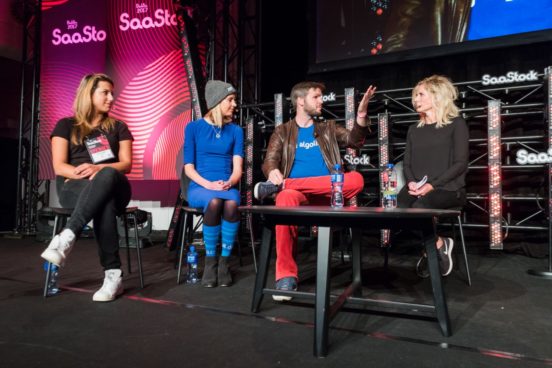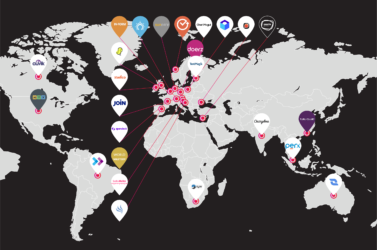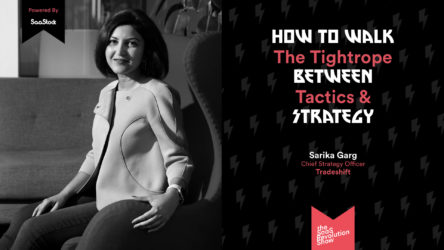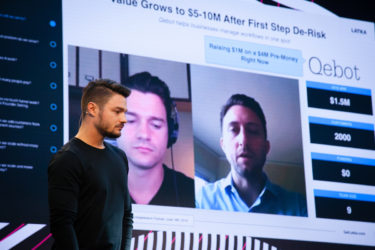What is a brand in a B2B world, how is it measured and tracked, and how can it be kept intact as a company grows? These were some of the topics a panel on branding discussed during SaaStock. Led by Adrienne Weissman, CMO of G2 Crowd, it featured Nicola Anderson, VP of Marketing at GoCardless, Lidia Lüttin, CMO of Bynder, and Liam Boogar, Brand Director of Algolia.
Below is a write up of their discussion, lightly edited for brevity.
How do you define what a brand is?
Nicola: Here’s what a brand is not. It’s not your logo, and it’s not swag, as much as I love my GoCardless socks. It’s what people say about you when you’re not in the room. It’s what customers and employees are saying about you.
Lidia: Your brand is also the human touch you give to your company. This human touch helps you differentiate from your competitors.
We all know that in the SaaS world, people are obsessed with metrics. But when it comes to the strength and health of your brand, those metrics are hard to define and track. What tools do you use for measurement and how often do the metrics change?
Nicola: Two things are important to check:
1) Brand awareness — How many people search for you and talk about you? How many people are coming to your site directly? For these, you could use tools like Brandwatch or Sprout Social.
2) Brand perception — What are people saying about you? To capture this, you could set up a short survey, using a tool like Typeform, or see customer reviews on a site like G2 Crowd.
Lidia: We measure brand growth in direct visits and mentions on social. We advertise a lot on YouTube, and we have a brand campaign there. We work with Google to measure how many people see our videos and how that influences our branded searches.
Liam: We look at similar things – site traffic, unique visitors, etc. That’s the end of the brand funnel. At the top of the funnel, we ask people who are our target, but not our users, about the problem we’re trying to solve. And we see if they think of us. There are “unassisted” and “assisted” parts of a survey like this.
NPS is God in our company. We have a feedback channel on Slack where we get every NPS review, and we can see our NPS average over the last 30 days. But I wouldn’t take too much credit for NPS – it is a reflection of the whole company. It includes the brand, but it’s also support, sales, product, and engineering. I like to look at metrics that can really guide my own decisions. But with NPS, looking at comments by detractors is very helpful.
Adrienne: Detractors are goldmines. Their comments give you the opportunity to publicly address problems in a meaningful way and fix them.
Lidia: You can learn what people don’t like and why they might leave. But you also learn the top 3 things that people love, and you can use that in your branding material.
(Tools like G2 Crowd and Delighted will capture customer NPS.)
Liam: We also look at customer support interactions. We don’t have a support team; our engineers handle everything. So we take a look and determine, “What are the questions that keep reoccurring?” You can also identify advantages that aren’t explicit advantages. Marketing can leverage those as bonuses. These aren’t reasons to use the product, but they are things we want to be associated with. You connect operational data with your marketing in a creative way, to incorporate it into your brand.

How do you ensure your team and employees have a buy-in to your brand and encourage your brand messaging?
Lidia: If your employees don’t know what your brand is about, then they can’t believe in it. Your brand needs to go into all the details. It’s every sales call. It’s how you answer the phone when the tech recruiter calls. At Bynder, we document and disseminate our brand; we share templates and logos. We approve every single piece of content that people create, even their personally-designed business cards. And we also document our brand guidelines, which everyone reads and is quizzed on after.
Employees also get points for brand promotion, and they can exchange those points for swag. Bynder also hosts OnBrand, an event in Amsterdam in October.
Nicola: You should brand your employees as soon as they walk in the door: hat, socks, tattoos, everything. That should include employees outside of the marketing department. You need buy-in from the whole company. Foster brand ambassadors in each department.
Liam: If you want to build a community, you have to be a community. Our branding decisions are about getting everyone involved. Everyone has access to the Algolia Twitter account. They can send something they think is cool, and it comes to the Marketing department, which revises and sends it out. We keep a low barrier to entry, so everyone feels involved in the brand. We involve people outside of marketing at events and talks. We help our engineers write content.
We also educate our team members on how to talk about sticky subjects, such as politics and competitors.
Anyone in the company can represent our brand because they have the tools. — Liam Boogar, Algolia
Adrienne: We’ve hired young, bright people and didn’t want to silence their voice. But you try to shape it so they can advocate your brand in their own words.
What are concrete suggestions that the audience can put to use today?
Liam: No matter how big or small you are, you can sit down with the founders and the rest of the team and answer these three things on paper:
- What do you think of yourself?
- How do you decide to communicate it?
- What do people think of you?
Review the answers, and try to get those threads as close together as possible. You want to converge them.
Nicola: Figure out your 3 Ps:
- Purpose – How will you make the world a better place?
- Position – How is it different from what’s already out there?
- Personality – If you met your brand at a party, what would you think about them?
Lidia: When developing your brand and values, don’t limit that to marketing. Involve the whole team. Create templates, and make sure people know where to find the templates.
How do you measure internal or external brand perception?
Liam: We use Office Vibe, a tool that lets you ping your team and ask questions every week. You get a sense of how motivated people are. There are also ways to measure your internal NPS.
How do you ensure brand consistency across languages and cultures?
Lidia: We always localize. It can be difficult, but if you review and approve all of your branding content, steadily (and no matter where it comes from), then nothing should go wrong.
We’ve hired young, bright people and don’t want to silence their voice. But you try to shape it so they can go advocate your brand in their own words. — Adrienne Weissman, G2 Crowd




